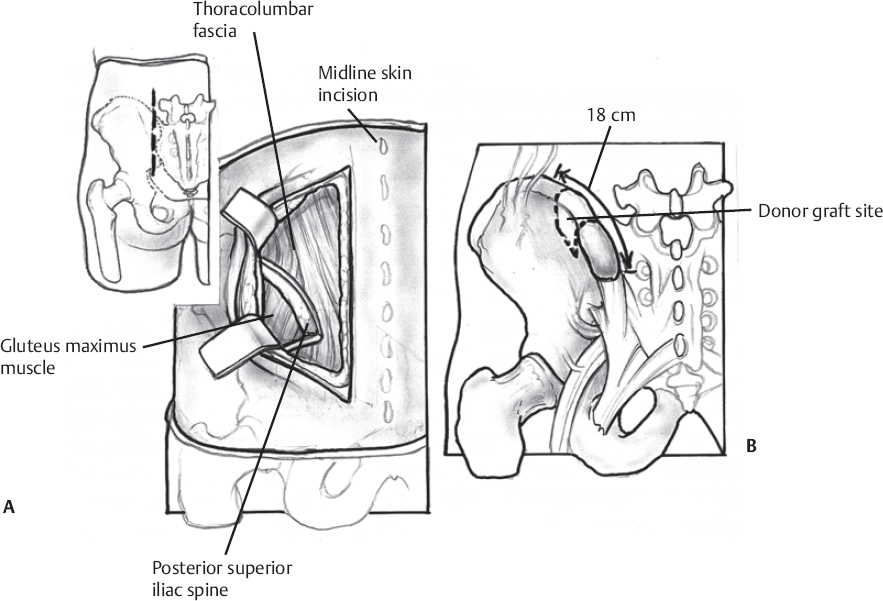♦ General Fusion Principles
- Autograft bone is the ideal bone graft because it combines three features that are essential for bone formation and healing.
- Osteoinduction: biologic recruitment and differentiation of cell types that will participate in bone formation via factors such as bone morphogenic proteins
- Osteoconduction: acts as a scaffolding for new bone formation
- Osteogenesis: capacity to form bone, usually via osteoblasts in bone marrow
- Allograft bone as well as synthetic bone grafts typically lack osteogenetic and osteoinductive capacity.
- Osteoinduction: biologic recruitment and differentiation of cell types that will participate in bone formation via factors such as bone morphogenic proteins
- Types of bone grafts: structural versus nonstructural
- Cancellous bone graft
- Usually from iliac crest or the vertebral body
- Contains all three elements for bone formation
- Does not resist compression → nonstructural
- Ideal as a filler for cages, strut grafts, or for posterolateral fusion
- Usually from iliac crest or the vertebral body
- Cortical bone graft
- From iliac crest, fibula, rib, calvarium
- Osteoconductive, poor osteoinduction, or osteogenesis
- Should be combined with bone marrow, cancellous bone, or fusion enhancers
- Ideal for reconstruction → structural (except for rib graft)
- From iliac crest, fibula, rib, calvarium
- Cortico-cancellous bone graft
- Iliac crest
- Harvesting of more extensive graft material is associated with a potential loss of structural integrity of the iliac crest.
- Combines structural properties with all three biological features required for successful bone formation
- Iliac crest
- Cancellous bone graft
- Instrumentation
- Instrumentation is used to immediately immobilize the spine and increase the fusion rate allowing for earlier mobilization of the patient and frequently avoids the use of external bracing. On occasion, spinal instrumentation can be removed once a solid fusion has occurred and/or there are concerns that it may interfere with bone growth in a pediatric patient. Only solid osseous fusion will ensure long-term spinal stability. Without osseous fusion metal instrumentation will eventually fail.
- Biomechanical principles of fusion
- Wolff’s law states that bony fusion occurs best under mechanical loading. Therefore, structural bone grafts should be kept under mechanical loading, whenever possible. “Stress shielding” occurs when rigid spinal instrumentation shields a structural bone graft from mechanical loading. This can result in a nonunion or osteoporosis.
♦ Graft Harvesting
Preoperative
Operative Planning
- Determine what type of bone graft is needed: structural or nonstructural.
- Depending on the site of the primary surgery, determine which harvesting site would be best and least invasive.
Equipment
- Is additional allograft needed or other bone enhancers?
- Depending on the site of graft harvesting, additional surgical tools may be needed: chisels, osteotomes, oscillating bone saws, Doyen subperiosteal elevator for rib grafts, etc.
- Bone grinder to morselize harvested bone
Intraoperative and Postoperative
Anterior Approach
- Anterior iliac crest (Fig. 126.1A)
- Cancellous and cortical, structural and nonstructural bone graft
- Incision parallel to iliac crest and at least 2 to 3 cm lateral from the anterior superior iliac spine to avoid inguinal ligament injury and avulsion fracture of the bone. Careful subperiosteal dissection is important to avoid injury to the ilioinguinal and other nerves in this region.
- Tricortical bone grafts should be fashioned with the oscillating bone saw.
- Hemostasis with Gelfoam and bone wax
- Multilayer wound closure
- Cancellous and cortical, structural and nonstructural bone graft
- Vertebral body
- The bone obtained during a corpectomy can be used as nonstructural graft for the subsequent fusion. It can be filled into the cage or the fibular allograft spacers used for the interbody reconstruction.
- Rib
- It provides cortical and some cancellous bone, but it is not a good structural graft.
- Rib can be easily harvested during an transthoracic approach for thoracic or lumbar pathology.
- Subperiosteal dissection is key to avoiding injury to the neurovascular bundle.
- It provides cortical and some cancellous bone, but it is not a good structural graft.
< div class='tao-gold-member'>
Only gold members can continue reading. Log In or Register to continue
Stay updated, free articles. Join our Telegram channel

Full access? Get Clinical Tree







